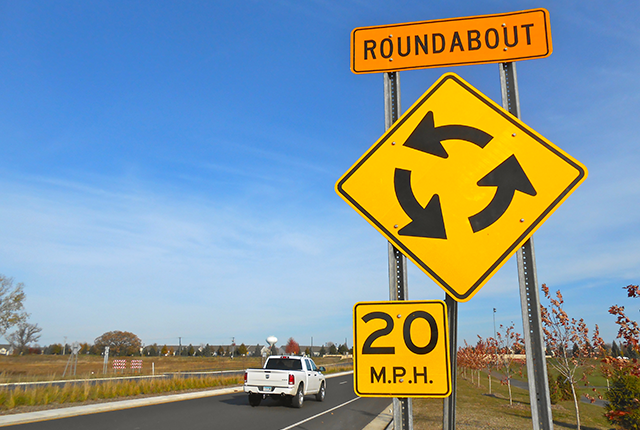Free Consultation

Do Roundabouts Reduce Car Crashes?
A modern roundabout is a circular intersection where drivers travel counterclockwise around a center island. There are no traffic signals or stop signs in a modern roundabout. Drivers yield an entry to traffic in the roundabout, then enter the intersection and exit at their desired location. According to the Federal Highway Administration (FHA), studies suggest that roundabouts can increase traffic capacity by 30- 50%, in comparison to traditional intersections. But for many, the big questions are: Do roundabouts really reduce crashes? Are roundabouts better than the more common four-way stop?
Advantages of Roundabouts
According to the Insurance Institute for Highway Safety, roundabouts have been shown to significantly decrease the number of crashes, particularly those with serious injuries.
The tight circle of a roundabout forces drivers to slow down, and the most severe types of intersection crashes — right-angle, left-turn and head-on collisions — are eliminated.
Roundabouts improve traffic flow and are better for the environment. Research shows that traffic flow improves after traditional intersections are converted to roundabouts. Less idling reduces vehicle emissions and fuel consumption.
Roundabouts are generally safer for pedestrians. Pedestrians of a roundabout walk on sidewalks around the perimeter and cross only one direction of traffic at a time. Crossing distances are relatively short, and traffic speeds are lower than at traditional intersections.
Statistics
According to the Insurance Institute for Highway Safety (IIHS), roundabouts have:
- Reduced injury crashes by 75% at intersections where stop signs or signals were previously used for traffic control.
- 37% reduction in overall collisions
- 75% reduction in injury collisions
- 90% reduction in fatality collisions
- 40% reduction in pedestrian collisions
While the overall and pedestrian collisions are fairly lower, these statistics speak volumes on how successful roundabouts are to reduce car crashes.
Disadvantages of Roundabouts
Despite the demonstrated safety benefits of roundabouts, some crashes still occur due to unsafe driving.
Speeding. It is important to reduce speed when approaching a traffic circle and while in it. People must yield to other drivers in the roundabout, and if a driver is speeding, he may not have sufficient time to slow down.
Not Using the Proper Lane. It is critical to obey the roadside signs that guide drivers—especially when the circle has more than one lane. These signs inform drivers how to exit the roundabout and what lane to use. When these important instructions aren’t followed, a crash can occur.
Stopping. Roundabouts are designed so traffic within the circle continuously moves. It is dangerous to stop once in the circle, unless absolutely necessary to avoid a crash.
Not Yielding to Traffic. When entering the roundabout, the driver must yield to vehicles already in the circle. Failing to do so can result in a crash.
Changing Lanes or Not Using a Turn Signal. Unless a driver needs to get into the other lane to exit the traffic circle, he needs to stay in his lane. If it is safer, the driver should get off at the wrong exit or go around again rather than change lanes at a hazardous time.
Crashes tend to be less serious in traffic circles due to the slower speeds, but they still can occur.
Contact Us
If you’ve been involved in a car crash in Pennsylvania, whether in a roundabout or otherwise, due to another driver’s negligence, reach out to an experienced car crash attorney. For a free consultation with our team at Scartelli Olszewski, P.C., contact us today.
Sources
Memorandum: Promoting and Implementing the Updated Proven Safety Countermeasures – 2017
Peter Paul Olszewski, Jr., a shareholder and managing partner at Scartelli Olszewski, P.C., brings 37 years of litigation experience. He is a renowned trial lawyer in Pennsylvania, specializing in medical malpractice, personal injury, and criminal defense. Peter's notable achievements include securing multi-million-dollar verdicts and serving as District Attorney and Judge. He is committed to community involvement and is actively engaged in various legal associations.
Linked In - https://www.linkedin.com/in/peter-paul-olszewski-jr-11115b1a/

